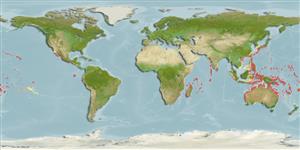Classification / Names
Common names from other countries
Main reference
Size / Weight / Age
Max length : 13.0 cm SL male/unsexed; (Ref. 48637)
Environment
Marine; reef-associated; depth range 8 - 20 m (Ref. 9710)
Climate / Range
Tropical, preferred ?; 35°N - 35°S
Distribution
Short description
Dorsal
spines
(total): 1 - 2;
Dorsal
soft rays
(total): 29-34;
Anal
spines: 0;
Anal
soft rays: 26 - 30. Body and head color variable. Blackish to dark bluish branchial blotch extending dorsally to level well above the lower margin of eye and may include ventrally the pectoral fin base and axil. Iris usually dark brown. Orange to red caudal fin soft dorsal and anal fins clear, orange or yellow with spots; pectorals clear. Scale spinulation at midbody closely packed. Male scale ridge rugosities develop at about 80 mm SL developed. Strong first dorsal spine. Large pelvic fin rudiment narrowly attached to posterior margin of ventral flap.
IUCN Red List Status (Ref. 115185)
Threat to humans
Harmless
Human uses
More information
Common namesSynonymsMetabolismPredatorsEcotoxicologyReproductionMaturitySpawningFecundityEggsEgg development
ReferencesAquacultureAquaculture profileStrainsGeneticsAllele frequenciesHeritabilityDiseasesProcessingMass conversion
Tools
Special reports
Download XML
Internet sources
Estimates of some properties based on models
Phylogenetic diversity index
PD50 = 0.5039 many relatives (e.g. carps) 0.5 - 2.0 few relatives (e.g. lungfishes)
Trophic Level
2.9 ±0.4 se; Based on size and trophs of closest relatives
Resilience
High, minimum population doubling time less than 15 months (Preliminary K or Fecundity.)
Vulnerability
Low to moderate vulnerability (25 of 100)
Price category
